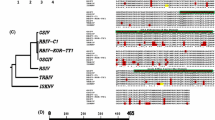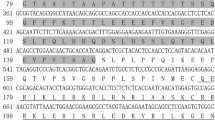Abstract
The phosphatidylinositol 3-kinase (PI3K)-AKT pathway is involved in various cellular functions, including anti-apoptosis, protein synthesis, glucose metabolism and cell cycling. However, the role of the PI3K-AKT pathway in crustaceans remains unclear. In the present study, we cloned and characterized the AKT gene lvakt from Litopenaeus vannamei. The 511-residue LVAKT was highly conserved; contained a PH domain, a catalytic domain and a hydrophobic domain; and was highly expressed in the heart and gills of L. vannamei. We found, using Real-Time Quantitative PCR (Q-PCR) analysis, that lvakt was up-regulated during early white spot syndrome virus (WSSV) infection. Moreover, the PI3K-specific inhibitor, LY294002, reduced viral gene transcription, implying that the PI3K-AKT pathway might be hijacked by WSSV. Our results therefore suggest that LVAKT may play an important role in the shrimp immune response against WSSV.
Similar content being viewed by others
References
Bellacosa A, Testa J R, Staal S P, Tsichlis P N. 1991. A retroviral oncogene, akt, encoding a serine-threonine kinase containing an SH2-like region. Science, 254: 274–277.
Bottomley M J, Salim K, Panayotou G. 1998. Phospholipidbinding protein domains. Biochim. Biophys. Acta, 1436: 165–183.
Cantrell D A. 2001. Phosphoinositide 3-kinase signalling pathways. J. Cell Sci., 114: 1 439–1 445.
Chen W Y, Ho K C, Leu J H, Liu K F, Wang H C, Kou G H, Lo C F. 2008. WSSV infection activates STAT in shrimp. Dev. Comp. Immunol., 32: 1 142–1 150.
Cooray S. 2004. The pivotal role of phosphatidylinositol 3-kinase-Akt signal transduction in virus survival. J. Gen. Virol., 85: 1 065–1 076.
Dawson C W, Tramountanis G, Eliopoulos A G, Young L S. 2003. Epstein-Barr virus latent membrane protein 1 (LMP1) activates the phosphatidylinositol 3-kinase/Akt pathway to promote cell survival and induce actin filament remodeling. J. Biol. Chem., 278: 3 694–3 704.
Downward J. 1998. Mechanisms and consequences of activation of protein kinase B/Akt. Curr. Opin. Cell Biol., 10: 262–267.
Huang X D, Zhao L, Zhang H Q, Xu X P, Jia X T, Chen Y H, Wang P H, Weng S P, Yu X Q, Yin Z X, He J G. 2010. Shrimp NF-kappaB binds to the immediate-early gene ie1 promoter of white spot syndrome virus and upregulates its activity. Virology, 406: 176–180.
Ji W T, Liu H J. 2008. PI3K-Akt signaling and viral infection. Recent Pat. Biotechnol., 2: 218–226.
Liu W J, Chang Y S, Wang A H, Kou G H, Lo C F. 2007. White spot syndrome virus annexes a shrimp STAT to enhance expression of the immediate-early gene ie1. J. Virol., 81: 1 461–1 471.
Livak K J, Schmittgen T D. 2001. Analysis of relative gene expression data using real-time quantitative PCR and the 2-ΔΔCt method. Methods, 25: 402–408.
Manning B D, Cantley L C. 2007. AKT/PKB signaling: navigating downstream. Cell, 129: 1 261–1 274.
Patel R K, Hardy R W. 2012. Role for the phosphatidylinositol 3-kinase-Akt-TOR pathway during sindbis virus replication in arthropods. J. Virol., 86: 3 595–3 604.
Saeed M F, Kolokoltsov A A, Freiberg A N, Holbrook M R, Davey R A. 2008. Phosphoinositide-3 kinase-Akt pathway controls cellular entry of Ebola virus. PLoS Pathog., 4: e1000141.
Saitou N, Nei M. 1987. The Neighbor-Joining Method: a new method for reconstructing phylogenetic trees. Mol. Biol. Evol., 4: 406–425.
Sarbassov D D, Guertin D A, Ali S M, Sabatini D M. 2005. Phosphorylation and regulation of Akt/PKB by the rictormTOR complex. Science, 307: 1 098–1 101.
Shin Y K, Liu Q, Tikoo S K, Babiuk L A, Zhou Y. 2007. Effect of the phosphatidylinositol 3-kinase/Akt pathway on influenza A virus propagation. J. Gen. Virol., 88: 942–950.
Soares J A, Leite F G, Andrade L G, Torres A A, De Sousa L P, Barcelos L S, Teixeira M M, Ferreira P C, Kroon E G, Souto-Padron T, Bonjardim C A. 2009. Activation of the PI3K/Akt pathway early during vaccinia and cowpox virus infections is required for both host survival and viral replication. J. Virol., 83: 6 883–6 899.
Song K K, Li D F, Zhang M C, Yang H J, Ruan L W, Xu X. 2010. Cloning and characterization of three novel WSSV recognizing lectins from shrimp Marsupenaeus japonicus. Fish Shellfish Immunol., 28: 596–603.
Tamura K, Dudley J, Nei M, Kumar S. 2007. MEGA4: Molecular Evolutionary Genetics Analysis (MEGA) software version 4.0. Mol. Biol. Evol., 24: 1 596–1 599.
Thompson J D, Higgins D G, Gibson T J. 1994. CLUSTAL W: improving the sensitivity of progressive multiple sequence alignment through sequence weighting, position-specific gap penalties and weight matrix choice. Nucleic Acids Res., 22: 4 673–4 680.
Vogt P K, Hart J R, Gymnopoulos M, Jiang H, Kang S, Bader A G, Zhao L, Denley A. 2010. Phosphatidylinositol 3-kinase: the oncoprotein. Curr. Top Microbiol. Immunol., 347: 79–104.
Wang P H, Gu Z H, Wan D H, Liu B D, Huang X D, Weng S P, Yu X Q, He J G. 2013. The shrimp IKK-NF-kappaB signaling pathway regulates antimicrobial peptide expression and may be subverted by white spot syndrome virus to facilitate viral gene expression. Cell Mol. Immunol., 10: 423–436.
Wang P H, Gu Z H, Wan D H, Zhang M Y, Weng S P, Yu X Q, He J G. 2011. The shrimp NF-kappaB pathway is activated by white spot syndrome virus (WSSV) 449 to facilitate the expression of WSSV069 (ie1), WSSV303 and WSSV371. PLoS One, 6: e24773.
Xiao W, Yang Y, Weng Q, Lin T, Yuan M, Yang K, Pang Y. 2009. The role of the PI3K-Akt signal transduction pathway in Autographa californica multiple nucleopolyhedrovirus infection of Spodoptera frugiperda cells. Virology, 391: 83–89.
Xie X, Li H, Xu L, Yang F. 2005. A simple and efficient method for purification of intact white spot syndrome virus (WSSV) viral particles. Virus Res., 108: 63–67.
Zhou Q, Qi Y P, Yang F. 2007. Application of spectrophotometry to evaluate the concentration of purified White Spot Syndrome Virus. J. Virol. Methods, 146: 288–292.
Author information
Authors and Affiliations
Corresponding author
Additional information
Supported by the Scientific Research Foundation of Third Institute of Oceanography, SOA (No. 2011018), the Natural Science Foundation of Fujian Province of China (No. 2011J05079), the National Natural Science Foundation of China (No. 31001125), the Major State Basic Research Development Program of China (973 Program) (No. 2012CB114403), the National High Technology Research and Development Program of China (863 Program) (No. 2012AA092205), and the China Agriculture Research System-47
RUAN Lingwei and LIU Rongdiao contributed equally to this work.
Rights and permissions
About this article
Cite this article
Ruan, L., Liu, R., Xu, X. et al. Molecular cloning and characterization of a threonine/serine protein kinase lvakt from Litopenaeus vannamei . Chin. J. Ocean. Limnol. 32, 792–798 (2014). https://doi.org/10.1007/s00343-014-3295-z
Received:
Accepted:
Published:
Issue Date:
DOI: https://doi.org/10.1007/s00343-014-3295-z




